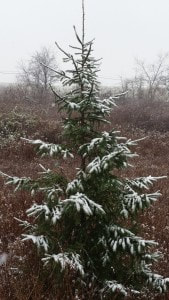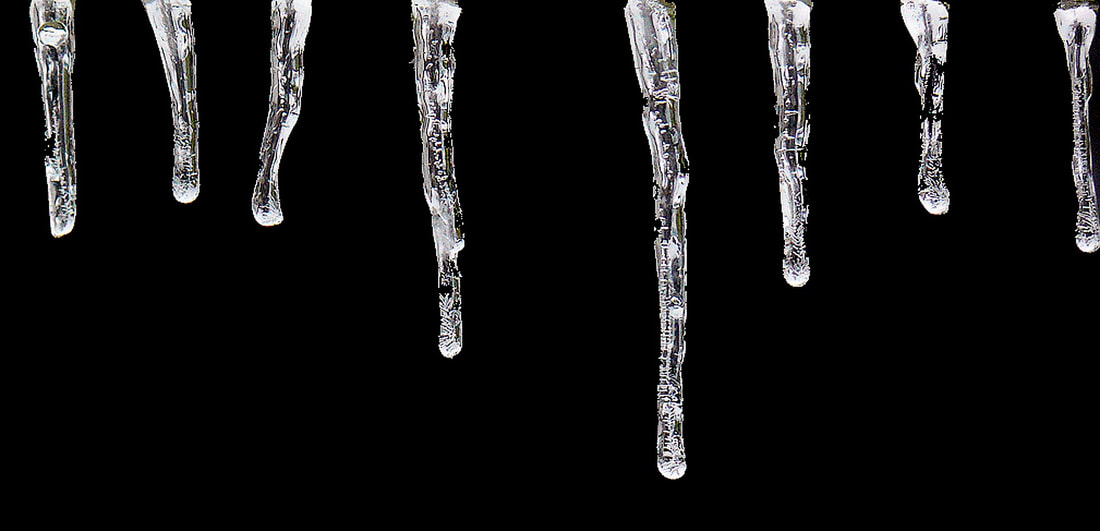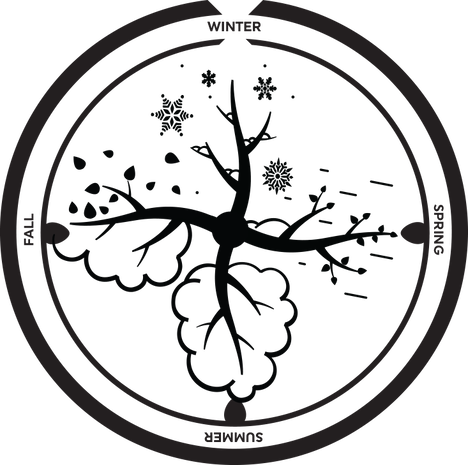|
Even for the most avid outdoor enthusiasts, winter can often be a time of dormancy, for humans as well as many other organisms. For many of us, winter weather means curling up with a good book and some soup because the idea of going outside is daunting. It’s cold, it’s wet, and there’s just not much to see. While those first two points can’t really be argued (although the right gear can make it bearable), that last point is simply not true. The truth is that many of us who opt to stay indoors until spring are missing out on some very interesting finds. In our very first ’10 Fun Facts’ of 2017, here are 10 things to know about winter ecology.  1. There’s more to snow than meets the eye. One of the biggest hindrances to getting outside can be snow. Sure it’s pretty to look at, but no fun to walk through and once we’re done with snowmen and snowball fights, what’s so interesting about it? Well as we’ve posted on our social media pages many times, snowshoes and cross country skis can make traversing across the snow a breeze. Once you do get to move around in it, you’ll discover that there’s actually quite a bit that’s interesting about snow. For starters, the kinds of snow can vary depending on how much moisture, how much ice, and how much air it contains. There can also be differences once it falls successively and starts to form layers. When that happens, the bottom layers tend to be warmer than the top layers. When this occurs, water vapor forms and creates a layer of snow that is granular, similar in texture to sugar. This allows small animals such as voles, mice, and shrews to tunnel through it. This layer contains a lot of air so it can provide insulation for certain animals to hunker down in at night when it’s cold and it easily allows hoofed herbivores to paw and easily access grass. 2. Watch those snowflakes! Snowflakes are formed as dust particles in the air collect water vapor as they continue to rise into the atmosphere. As they get higher, the water vapor freezes and begins to form a crystal. The crystal gets bigger and heavier and then begins to fall. As it does so, it meets and sticks with other snowflakes and as they fall to the ground, they clump together, forming snow. During the average snowstorm, approximately 20 trillion snowflakes will fall at about 3 mph (on average). Each of those snowflakes will have six sides. 3. Many plant structures and growth patterns are in response to the pressures of winter. Annual plants will grow from seed and then spend the spring, summer, and early fall producing more seeds. These seeds may disperse on the wind, fall to the ground, or come in the protective casing of berries that are eaten and then subsequently excreted in a new location by animals. In the winter, the seed producing plant dies and the seeds germinate to grow the next spring. Biennial plants are similar but live for two years. In the first year, their stems and leaves die but the root remains alive in the ground. The second year is when they produce seeds before dying in their second winter. Burdock root is an example of a biennial plant. Perennial plants such as cattails die back to the ground in the winter with the root staying alive to grow another plant in the spring. These growth patterns are largely in response to the pressures of winter, allowing the species as a whole to survive. Additionally, many plant shapes are specifically to survive winter weather. The cone shape of evergreen trees is a design that provides resiliency to heavy snow loads. As the weight of snow presses on them, sloped out branches allow it to simply fall off when too heavy, rather than collapsing the structure of the tree. It’s been said that the idea of peaked roofs was based on observations of this concept. 4. Insect life cycles are often timed in sync with the seasons so that they can survive winter. Many insects overwinter in the life cycle that requires the least energy and is best suited to the harsh conditions of winter. For insects with incomplete metamorphosis such as grasshoppers and crickets, this is usually in egg form. For insects with complete metamorphosis such as butterflies, this is usually in larval form. Insects that overwinter as adults usually do so in sheltered habitats such as under leaves, tree crevices and bark, rocks, etc. For those of us who see brown marmorated stink bugs in our homes, we usually see them primarily in the spring and fall. The reason for this is because they are overwintering in the small crevices in our homes, coming in during the fall and leaving in the spring. 5. Many bird species are surprisingly common in the winter months. Many of Pennsylvania’s bird species migrate south during the winter months. Robins fly in a southward direction, although they don’t follow a particular migration path, opting instead to simply go where they can find food. Turkey vultures, a common site in spring, summer, and fall skies, can’t tolerate our cold winters and head south. They will follow a particular migration route by opening their wings wide and soaring along thermal air currents, expending very little energy in the process. Despite many bird species heading south for the winter, there are several species of birds that breed north of here and actually consider Western Pennsylvania their southbound destination. Dark eyed juncos and red breasted nuthatches are common sites at winter bird feeders, joining alongside bird species that remain throughout the year such as cardinals and blue jays. Some snowy owls, a ‘bucket list’ bird species for many birders, also consider the state of Pennsylvania their southern home. They can usually be found hunting along beach areas so locations such as Keystone State Park can sometimes be ideal for spotting them during the months of December-early March. 6. No birds? No problem! Look for nests! If you look carefully along your winter walks, you’ll most likely spot lots of nesting areas in the trees, since the leaves are gone, making them more visible. Think they all look the same? Look again! When the nests are visible in the winter time, you can get a great idea of your bird populations by looking at and identifying nest types. Many of our bird field guides, available for checkout in our library, have pictures and/or descriptions of nests. 7. You can look, but it’s against the law to touch the nests. Most people know that it’s illegal to collect or have bird feathers, eggs, and dead birds under the Migratory Bird Treaty Act of 1918. It’s also illegal, under this act, to touch or remove nests as well, even if they are inconveniently placed. The reason for this is that many bird species return to the same nesting site each year. If they return to a nest that has been removed or agitated, they may not nest that year which would affect the population. If a nest does happen to be placed in an inconvenient location, it requires extensive permitting in order to remove it. The best course of action is to either call a professional service that is licensed or to let the nest run its course (in the case of a nest that is newly created in the spring. 8. Many birds of prey begin nesting and mating rituals in mid to late winter, and it can be pretty spectacular! According to the Eagles of Hays Pa Facebook page, the Hays eagles, the first eagles to nest within Pittsburgh city limits in over 200 years, have already started hanging out at their nesting site. Around late January to early February, many bald eagles will start their elaborate courtship rituals which involve spectacular flighted dances such as the one seen in this video. Red tailed hawks will also start very similar courtship rituals such as this one (the actual dance starting at the 4:16 mark). Eagles are more commonly found near bodies of water as their preferred prey is fish, so they are not typically seen around WPNR. It is not uncommon, however, to see several pairs of red tailed hawks undergoing this spectacular mating ritual in January and February. 9. Many organisms don’t survive winter for various reasons and there’s a term for that. The term ‘winterkill’ refers to the rise in mortality rate in the winter months of many plants and animals as a result of the combined effects of bad weather, malnutrition, starvation, disease, and predation. 10. Don’t let Number 9 deter you! If you’re interested in exploring winter ecology for yourself but are intimidated by number 9, WPNR is happy to help. WPNR is often seen as a safe place to start winter explorations for various reasons. It’s a 50 acre reserve, so no matter how much you walk, you are always within close proximity to the Environmental Learning Barn which is heated, has a library, bathrooms, and water. The Barn is also where our helpful staff is located and we’re happy to discuss equipment and clothing that is best suited to keep you comfortable during colder temperatures. Additionally, our library has field guides of all kinds to assist you with your explorations as well as snowshoes that can be checked out and used on reserve grounds. Call us at (724) 537-5284 if you have any questions or stop by The Barn during our operating hours of Tuesday-Friday 10AM-4PM for more information. We look forward to assisting you as you explore all that this underrated season has to offer! Bibliography
Written by Jean H. Keene
0 Comments
Leave a Reply. |
AboutThe Walzer Way Blog is maintained by WPNR staff with contributions from Saint Vincent College students and staff, volunteers, community members, and more. If you are interested in contributing to The Walzer Way Blog, contact the Learning Barn. Categories
All
Archives
March 2020
|



 RSS Feed
RSS Feed

